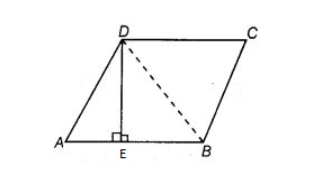
ABCD is a rhombus in which Altitude from D to side AB bisects AB. Find the angles of the rhombus? Altitude from D to side AB bisects AB.
A. 110, 70, 110, 70
B. 120, 60, 120, 60
C. 125, 55, 125, 55
D. 135, 45, 135, 45
Answer
581.1k+ views
Hint: To solve this question, we need to know the basic theory related to the quadrilateral. As we know rhombus is a type of quadrilateral and also It is a special case of a parallelogram, whose diagonals intersect each other at 90 degrees. Here, by using various theorems or properties we will Find the angles of the rhombus.
Complete step-by-step answer:
Given that ABCD is a Rhombus and DE is the altitude on AB then AE= EB

In a $\vartriangle $AED and$\vartriangle $BED,
DE = DE (common line)
$\angle $AED = $\angle $BED (right angle)
AE = EB (DE is an altitude)
∴ $\vartriangle $AED ≅$\vartriangle $ BED (SAS property)
∴ AD = BD (by C.P.C.T)
But AD = AB ( Sides of rhombus are equal)
$ \Rightarrow $ AD = AB = BD
$\therefore $ ABD is an equilateral triangle.
$\therefore $ $\angle $A = ${60^0}$
\[ \Rightarrow \angle A{\text{ }} = \angle C{\text{ }} = {\text{ }}60^\circ \]( opposite angles of a rhombus are equal )
Always, when we add adjacent angles of a rhombus, it is supplementary in nature.
$\angle $ABC + $\angle $BCD = ${180^0}$
$ \Rightarrow $ $\angle $ABC + ${60^0} = {180^0}$
$ \Rightarrow $ $\angle $ABC = ${180^0} - {60^0} = {120^0}$
∴ $\angle $ABC = $\angle $ADC = ${120^0}$. (opposite angles of rhombus are equal)
∴ Angles of rhombus are \[\angle A{\text{ }} = {\text{ }}60^\circ and\angle C{\text{ }} = {\text{ }}60^\circ ,\angle B{\text{ }} = \angle D{\text{ }} = {\text{ }}120^\circ .\]
Therefore, option (B) is the correct answer.
Note:Rhombus has all its sides equal and so does a square. Also, the diagonals of any square are perpendicular (means ${90^ \circ }$) to each other and bisect the opposite angles. Therefore, a square is a type of rhombus. In rhombus the opposite angles are equal to each other. Also, in rhombus the diagonals bisect these angles.
Complete step-by-step answer:
Given that ABCD is a Rhombus and DE is the altitude on AB then AE= EB

In a $\vartriangle $AED and$\vartriangle $BED,
DE = DE (common line)
$\angle $AED = $\angle $BED (right angle)
AE = EB (DE is an altitude)
∴ $\vartriangle $AED ≅$\vartriangle $ BED (SAS property)
∴ AD = BD (by C.P.C.T)
But AD = AB ( Sides of rhombus are equal)
$ \Rightarrow $ AD = AB = BD
$\therefore $ ABD is an equilateral triangle.
$\therefore $ $\angle $A = ${60^0}$
\[ \Rightarrow \angle A{\text{ }} = \angle C{\text{ }} = {\text{ }}60^\circ \]( opposite angles of a rhombus are equal )
Always, when we add adjacent angles of a rhombus, it is supplementary in nature.
$\angle $ABC + $\angle $BCD = ${180^0}$
$ \Rightarrow $ $\angle $ABC + ${60^0} = {180^0}$
$ \Rightarrow $ $\angle $ABC = ${180^0} - {60^0} = {120^0}$
∴ $\angle $ABC = $\angle $ADC = ${120^0}$. (opposite angles of rhombus are equal)
∴ Angles of rhombus are \[\angle A{\text{ }} = {\text{ }}60^\circ and\angle C{\text{ }} = {\text{ }}60^\circ ,\angle B{\text{ }} = \angle D{\text{ }} = {\text{ }}120^\circ .\]
Therefore, option (B) is the correct answer.
Note:Rhombus has all its sides equal and so does a square. Also, the diagonals of any square are perpendicular (means ${90^ \circ }$) to each other and bisect the opposite angles. Therefore, a square is a type of rhombus. In rhombus the opposite angles are equal to each other. Also, in rhombus the diagonals bisect these angles.
Recently Updated Pages
Master Class 9 Social Science: Engaging Questions & Answers for Success

Master Class 9 Science: Engaging Questions & Answers for Success

Master Class 9 English: Engaging Questions & Answers for Success

Master Class 9 Maths: Engaging Questions & Answers for Success

Master Class 9 General Knowledge: Engaging Questions & Answers for Success

Class 9 Question and Answer - Your Ultimate Solutions Guide

Trending doubts
Which places in India experience sunrise first and class 9 social science CBSE

Fill the blanks with the suitable prepositions 1 The class 9 english CBSE

Write the 6 fundamental rights of India and explain in detail

Difference Between Plant Cell and Animal Cell

What is pollution? How many types of pollution? Define it

What is the Full Form of ISI and RAW




